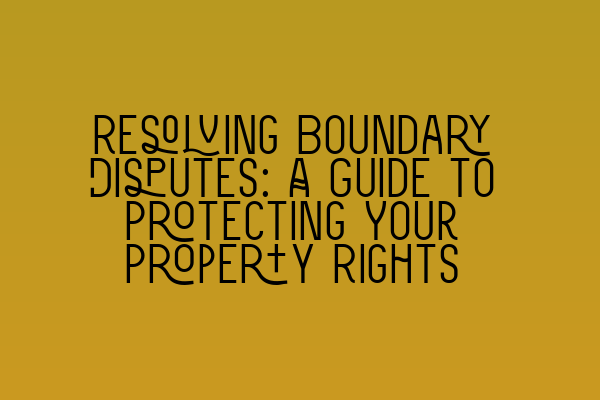Resolving Boundary Disputes: A Guide to Protecting Your Property Rights
Owning a property is a significant investment, and maintaining clear boundaries is vital to protect your property rights. However, boundary disputes can arise, causing stress and potential legal complications. In this comprehensive guide, we will discuss the various aspects of resolving boundary disputes and provide you with the knowledge to protect your property.
Understanding Boundary Disputes
A boundary dispute is a legal conflict between two or more parties over the location, ownership, or use of a property boundary. These disputes can arise due to a variety of reasons, such as ambiguous property descriptions, encroachments, disagreements over fences or structures, or errors in surveys or land records.
Resolving boundary disputes requires a careful examination of the relevant laws, property documents, surveys, and other evidence. It is crucial to consult with a qualified property law solicitor to guide and represent you throughout the process.
The Importance of Clear Property Boundaries
Clear property boundaries are essential for several reasons:
- Protection of Property Rights: Clear boundaries ensure that you have exclusive control and access to your property.
- Prevention of Encroachments: Properly demarcated boundaries prevent encroachments from neighboring properties, avoiding potential disputes.
- Property Value: Clearly defined boundaries contribute to the overall value of your property.
Now, let’s delve into the steps involved in resolving boundary disputes:
Step 1: Gather Relevant Documents and Evidence
Begin by gathering all relevant property documents, including deeds, title documents, surveys, and any other evidence related to the boundary in dispute. These documents will serve as the foundation for your case.
Related Articles: Understanding Contractual Capacity: Rights and Limitations, Contract Law Reforms: An Analysis of Recent Changes
Step 2: Conduct a Thorough Boundary Survey
A professional boundary survey is crucial to accurately determine the location and dimensions of the disputed boundary. Engage a qualified surveyor to conduct the survey and prepare an accurate report. This report will serve as crucial evidence during the dispute resolution process.
Step 3: Open Communication with Your Neighbor
It is often helpful to engage in open and respectful communication with your neighbor before pursuing legal action. Discuss the boundary issue with them, present your evidence, and try to reach an amicable resolution. Mediation or negotiation can be effective in resolving boundary disputes without resorting to expensive and time-consuming litigation.
Step 4: Seek Legal Advice
If informal resolution attempts fail, it is essential to seek legal advice from a specialist property law solicitor. They will carefully analyze the facts, evidence, and applicable laws to provide you with the best course of action. A solicitor can also represent you during negotiations or in court, if necessary.
Related Articles: Interactive SQE Mock Tests for Contract Law: Test Your Knowledge, Join Our SQE Contract Law Webinars: Expert Insights and Guidance
Step 5: Alternative Dispute Resolution
Mediation or other forms of alternative dispute resolution (ADR) can provide a cost-effective and efficient way to resolve boundary disputes. A neutral third-party mediator facilitates discussions between the parties to find a mutually satisfactory solution. ADR can save time and money compared to going to court.
Step 6: Court Proceedings
If all other attempts at resolution fail, you may need to pursue a court case to settle the boundary dispute. Your solicitor will prepare the necessary legal documents and represent you during the proceedings. It is crucial to have a skilled legal professional who can present a convincing case and protect your property rights.
Related Articles: Parties in a Contract: Rights and Responsibilities
Step 7: Compliance with Court Order
If the court issues a judgment or order regarding the disputed boundary, it is crucial to comply with it. Failure to comply with a court order can result in serious legal consequences. Ensure that you understand the terms of the judgment and take appropriate actions to implement them.
Resolving boundary disputes can be a complex and challenging process. It requires a deep understanding of property law and experience in negotiation and litigation. Hiring a qualified property law solicitor is the best way to ensure the protection of your property rights.
At SQE Property Law & Land Law, we have a team of experienced property law solicitors who specialize in resolving boundary disputes. Contact us today for expert advice and guidance in protecting your property rights.
